

Nutrition Support and the Gastrointestinal Microbiota: A Systematic Review - Journal of the Academy of Nutrition and Dietetics. Correia M.I.

Waitzberg D.L. The impact of malnutrition on morbidity, mortality, length of hospital stay and costs evaluated through a multivariate model analysis.Clin Nutr. 2003; 22: 235-239Elke G. van Zanten A.R. Nutrition Support and the Gastrointestinal Microbiota: A Systematic Review. Management of Glucose Control in Noncritically Ill, Hospitalized Patients Receiving Parenteral and/or Enteral Nutrition: A Systematic Review. 1.
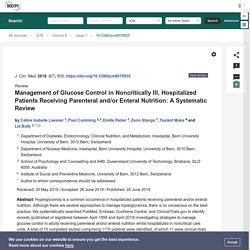
Introduction Hyperglycemia is frequently encountered during parenteral (PN) and/or enteral (EN) nutrition in hospitalized patients with and without pre-existing diabetes [1,2]. Indeed, it is estimated that more than 50% of patients on PN and 30% of patients on EN experience hyperglycemia whilst in the hospital [3,4]. Hyperglycemia arises in these patients due to one or more of the following factors: (1) diminished insulin sensitivity due to inflammation, stress hormones, and sedentarism [5]; (2) increased carbohydrate provision [6]; and (3) side-effects of medication such as glucocorticoids that interfere with glucose metabolism [7].
In patients totally reliant on PN, these factors are compounded by the loss of the physiological incretin effect on insulin release, as occurs when entirely bypassing the gastrointestinal tract with intravenous nutrient supply [8]. Standards for Nutrition Support: Adult Hospitalized Patients - Ukleja - 2018 - Nutrition in Clinical Practice. Introduction.

Lipids in the intensive care unit: Recommendations from the ESPEN Expert Group. Nutrition support for adults: oral nutrition support, enteral tube feeding and parenteral nutrition. This guideline covers identifying and caring for adults who are malnourished or at risk of malnutrition in hospital or in their own home or a care home.
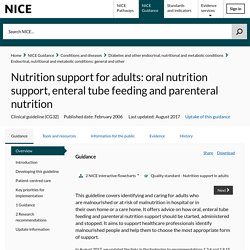
It offers advice on how oral, enteral tube feeding and parenteral nutrition support should be started, administered and stopped. It aims to support healthcare professionals identify malnourished people and help them to choose the most appropriate form of support. In August 2017, we updated the links in the footnotes to recommendations 1.3.4 and 1.8.15. Recommendation 1.7.17 was also updated and links added to National Patient Safety Agency documents. Recommendations This guideline includes recommendations on: Who is it for? All healthcare workers in hospital and the community who are directly involved in patient carePeople who are malnourished or at risk of malnutrition in hospital or in their own home or a care home and their families and carers Is this guideline up to date?
We reviewed the evidence in July 2017. ESPEN guidelines on nutritional support for polymorbid internal medicine patients - ScienceDirect. Background & aims Polymorbidity (also known as multimorbidity) – defined as the co-occurrence of at least two chronic health conditions – is highly prevalent, particularly in the hospitalized population.

Nonetheless, clinical guidelines largely address individual diseases and rarely account for polymorbidity. The aim of this project was to develop guidelines on nutritional support for polymorbid patients hospitalized in medical wards. Methods The methodology used for the development of the current project follows the standard operating procedures for ESPEN guidelines.
Results From a total of 4532 retrieved abstracts, 38 relevant studies were analyzed and used to generate a guideline draft that proposed 22 recommendations and four statements. Conclusions. Role of Nutrition Support in Inflammatory Conditions. Enteral and Parenteral Nutrition in the Perioperative Period: State of the Art. Standards for Nutrition Support Pediatric Hospitalized Patients. Carbohydrates and insulin resistance in clinical nutrition: Recommendations from the ESPEN expert group. Standards of Nutrition Care Practice and Professional Performance for Nutrition Support and Generalist Nurses. A practical and evidence-based approach to management of inpatient diabetes in non-critically ill patients and special clinical populations. ESPEN guideline on ethical aspects of artificial nutrition and hydration.
Statement 5: If the risks and burdens of a given therapy for a specific patient outweigh the potential benefits, then the physician has the obligation of not providing (withholding) the therapy.
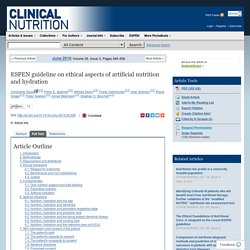
[Strong Consensus] Commentary Health care personnel have the obligation to maximize potential benefits for their patients while at the same time minimizing potential harm for them (“Primum non nocere”). Still, there is a distinction between beneficence and non-maleficence as those two principles have clear and different obligations. Statement 6: Even when artificial nutrition and hydration will be stopped, standard care to maintain a best possible quality of life to the patient has to be maintained. Statement 7: Artificial nutrition is used in accordance with a realistic goal of individual treatment, and the wishes of the patient himself/herself, and based on assessment of the situation by the doctor and other healthcare professionals.
Statement 8: Statement 9: Nutrition Therapy in the Adult Hospitalized Patient. A list of questions and recommendations were compiled by the group of experts on the guideline committee.
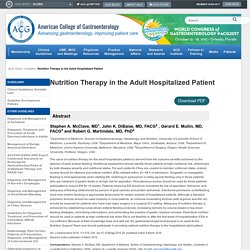
A literature search was performed using Embase, Pubmed, MEDLine, Cochrane Database, Google search for scholarly articles, and personal files of committee members. Search terms included tube feeding, EN, PN, enteral access, percutaneous endoscopic gastrostomy and jejunostomy, nasojejunal, and nutritional risk. Quality of evidence was determined using GRADE methods, based on study design, study quality, consistency, and directness (Table 1) (25). Four levels of evidence were assigned based on study limitations, inconsistency of results, and uncertainty about the directness of evidence (Table 2) (25).
Strength of recommendation was assigned as “Strong” if supported by moderate-to-high quality of evidence (RCTs and high-quality observational studies) or “Conditional” if supported by low quality of evidence (low-quality RCTs, observational studies, or expert opinion; Table 3) (25, 26). American Society for Parenteral and Enteral Nutrition (A.S.P.E.N.) Standards of Practice for Nutrition Support Pharmacists. Nutrition Support of Hospitalized Adult Patients With Obesity. Background As of June 2013, the American Medical Association recognized obesity as a disease that requires medical treatment.1,2 Based on the National Health and Nutrition Examination Survey 2009-2010, the prevalence of obesity in the United States is 35.5% in adult men, 35.8% in adult women, including 4.4% and 8.2% respectively with body mass index (BMI) ≥ 40 kg/m2.3 Thus, nutrition support clinicians are likely to care for obese patients, particularly during hospital admissions.
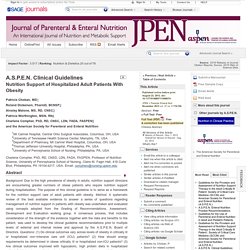
While nutrition support clinicians care for patients across a broad range of clinical settings, the bulk of publications available for this clinical guideline have come from hospitalized patients. Furthermore, since the clinical acuity of patients admitted to intensive care units (ICUs) is much higher than those who are not critically ill, for this guideline most recommendations have been made separately for these 2 groups of obese hospitalized patients when data were available. Method. A.S.P.E.N. Standards for Nutrition Support Home and Alternate Site Care. Abstract.
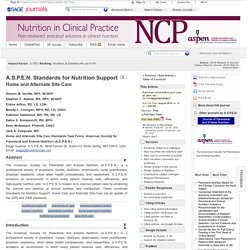
Indicators Recommended for the Identification and Documentation of Pediatric Malnutrition (Undernutrition): Consensus Statement of the Academy of Nutrition and Dietetics/American Society for Parenteral and Enteral Nutrition. 2014 Standards of Practice and Standards of Professional Performance for Registered Dietitian Nutritionists (Competent, Proficient, and Expert) in NutritAmerican Society for Parenteral and Enteral Nutrition and Academy of Nutrition and Dietetics: Revised.
All registered dietitians are nutritionists, but not all nutritionists are registered dietitians.
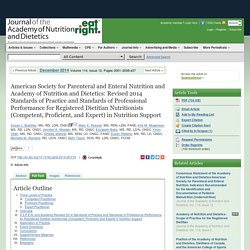
The Academy's Board of Directors and Commission on Dietetic Registration have determined that those who hold the credential Registered Dietitian (RD) may optionally use “Registered Dietitian Nutritionist” (RDN) instead. The two credentials have identical meanings. In this document, the expert working group has chosen to use the term RDN to refer to both registered dietitians and registered dietitian nutritionists. A.S.P.E.N. Clinical Guidelines: Nutrition Support of Adult Patients With Hyperglycemia. Nutrition Support of Neonatal Patients at Risk for Metabolic Bone Disease. Nutrition Support of Neonatal Patients at Risk for Metabolic Bone Disease Charlene Compher, PhD, RD, CNSC, LDN, FADA, University of Pennsylvania School of Nursing, Claire M.
Fagin Hall, 418 Curie Blvd, Philadelphia, PA 19104-4217, USA. Email: compherc@nursing.upenn.edu. Abstract Background: Premature infants are at increased risk for metabolic bone disease, with resulting delayed bone growth, osteopenia, and rickets. Background Accurate diagnosis and evaluation coupled with a solid understanding of the factors associated with the disease are necessary to accurately identify high-risk patients in order to effectively focus preventive efforts.
In the current guidelines, we aim to identify maternal and neonatal factors that place infants at risk for metabolic bone disease and provide a rationale for nutrition strategies to prevent and treat the condition.